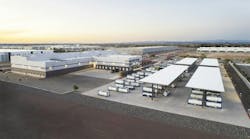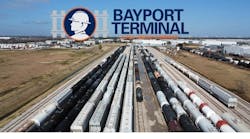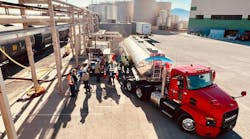JAMES Fallon made three key points as the opening speaker for the International Liquid Terminals Association’s 2014 International Operating Conference, held June 2-4 in Houston, Texas.
In his presentation entitled “The evolution of US shale plays and movement of liquid product,” he stated that the landscape of the North American energy infrastructure is changing rapidly with a corresponding major increase in midstream investment. Fallon is director of Downstream Energy Consulting for IHS Global Inc, an energy market research company.
Point number two is that the storage terminal industry is shifting focus from an increasingly import orientation (lasting from 1970 to 2010) to an export model. The first export shipment of condensate reportedly was loaded in Houston in early August.
For point number three, Fallon cautions that it will be critical for storage terminal operators to understand the dynamics (both volume and quality) of individual shale plays and where the next emerging shale plays are located to be able to develop successful strategies to capitalize on what he is calling the “Great Revival” that started in the US oil industry in the mid-2000s.
Running out
Fallon began his presentation by reminding his audience that as recently as 2005, so-called energy experts were claiming that the United States was running out of natural gas and crude oil. The United States was destined to become the largest energy importer in the world, and petroleum transport and logistics infrastructure was designed and built around imports.
“Between 2000 and 2008, we were building liquefied natural gas import terminals, and we saw increasing crude oil imports,” Fallon said. “Canadian crude was going to refineries in the Midwest. Crude oil shipments from the Middle East and Latin America were going to Gulf Coast and West Coast destinations. A new Canadian pipeline infrastructure came on line.
“Imports accounted 60% of our petroleum consumption by 2008. The US petrochemical industry was built on cheap feedstocks and, as domestic production of natural gas and natural gas liquids fell, the industry stagnated and contracted.”
Then the “Great Revival” occurred, starting in the mid-2000s. With the price of oil rising, exploration and production companies began combining horizontal drilling with hydraulic fracturing, which had been pioneered in the 1950s. The initial focus was on natural gas but it soon shifted to natural gas liquids and crude oil.
First wave
The first wave (sometimes called the “Shale Gale”) occurred in 2005-2010. It was largely a natural gas story in shale basins such as the Barnett (Texas), Haynesville (northwest Louisiana), Fayetteville (Arkansas), and the Marcellus (western Pennsylvania).
As oversupply depressed natural gas prices, producers applied natural gas techniques to liquids rich and crude oil shale plays. What followed was the second wave of the “Great Revival” beginning in 2010 and continuing today. It has brought an almost complete reversal of US petroleum liquids production declines and is facilitating a dramatic reconfiguration of the US energy infrastructure.
US domestic natural gas production increased by approximately 20 billion cubic feet per day ((BCF/D) since 2005. Net natural gas imports decreased by approximately 4 BCF/D in 2013, and the United States is projected to be a net exporter of natural has by 2017.
US natural gas liquids production (from gas processing) increased by 700,000 barrels per day since 2008, a 40% increase. US crude oil and condensate production increased by 3.2 million barrels per day since 2008, a 64% increase.
US net imports of petroleum liquids (crude oil, natural gas liquids, and refined products) have decreased by 6.5 million barrels per day since 2005, a 54% drop. All of this is having a major positive impact on the US economy.
More drilling
Drilling activity continues to increase. Total oil well completions were 27,400 in 2012, up from a 2005-2010 average of less than 14,000. “We’re expecting well completions in the range of 30,000 for 2013,” Fallon said.
As a result, natural gas liquids production is reaching four million barrels per day, and Fallon said it is critical for the United States to allow exports of these products to protect prices.
US Crude oil production is roughly 8.2 million barrels per day and is projected to increase to around 10.5 to 11.5 million barrels per day. Most importantly, this is high-quality light crude. US oil output will rival Russia and Saudi Arabia, according to Fallon.
Handling the massive increase in natural gas and crude oil has been a challenge. A huge effort has been underway since 2012 to bring new energy infrastructure online to move the products to market.
On the liquid pipelines side, a major construction boom was initiated to build new lines and repurpose existing pipelines for crude oil, diluent, and Y-grade natural gas liquids.
New intersection
The pipeline intersection in the United States has moved from Cushing, Oklahoma, to the Gulf Coast. Cushing volumes have been cut in half, as the infrastructure shifts to an export focus.
“We’re seeing the emergence of large east-west pipelines,” Fallon said. “Companies are building more gas processing and natural gas liquids fractionation plants. More storage tanks are being built.
“Crude-by rail has been an enormous story for the United States. We’re also seeing more crude-by-barge shipments. Rail is moving 800,000 barrels of crude per day right now, and volumes could reach 1.2 to 1.3 million barrels per day. More storage capacity and loading facilities will be needed to handle this growth.”
The domestic energy production renaissance has been especially beneficial to the petrochemical industry, which is in the midst of its own construction boom. A major wave of new olefins steam crackers is about to come online. Although ethylene and propylene will not impact liquid storage terminals, many of the derivatives will, according to Fallon.
The petroleum industry clearly is focused on exports in the not-too-distant future. Import-oriented storage facilities are being repurposed to serve a multi-purpose function. The first liquefied natural gas export terminals are coming on line.
Next on deck: an industrywide push for liberalization of federal restrictions on exports of US crude oil and condensate. “Why do we have a ban today? Fallon asked. “It’s purely political, and it goes back to the Arab oil embargo of the 1970s.” ♦










